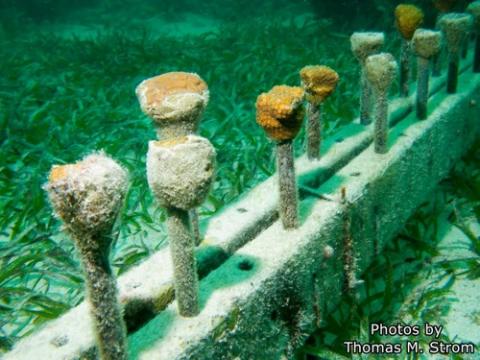As Professor Bob pointed out two weeks ago, one of the must-see things at Biscayne National Park are the reefs teeming with rainbow-hued fish, corals, and sponges. While these delicate structures struggle with warming waters, disease, and physical assaults from boaters, divers, and anglers, volunteers at the park are working to preserve them by nurturing coral nurseries.
Every Saturday the Coral Nursery Club, which was organized in 1993, meets to work on three objectives: to rescue coral fragments resulting from inadvertent vessel groundings in park waters; to develop and maintain a supply of natural coral colonies with a diversity that reflects natural conditions in the park; and to provide a platform for community volunteers to participate and learn the intricacies of coral reef management and restoration.
According to the National Park Service, "more than 27 percent of the planet’s reefs are gone or have been seriously damaged by boat collisions, polluted water, climate change, and disease. Although reefs are less than 1 percent of the earth’s surface, they harbor more than 70 percent of the marine species. Biscayne National Park is home to part of the third largest coral reef track in the world. It’s also a popular fishing, boating, and diving destination, and park rangers and community partners are working closely to prevent reef damage and identify ways to repair damage already done. One promising option: park scientists and volunteers are salvaging pieces of broken coral and nurturing them back to health. The park’s veteran coastal oceanographer, Richard Curry, says “the coral nursery research is giving us new insight about coral growth, reproduction, and the viability of re-seeding coral reefs. Our community volunteers are developing scientific processes that offer hope for coral reef recovery worldwide.”
Part of the club's activities focus on generating new corals by searching out reefs that have been damaged by boat groundings or some other disturbance and collecting fragments of broken corals. Those pieces then are taken to the park's nursery, where they are bonded to PVC stakes and nurtured for use either for restoration projects or reef enhancement, according to Dr. Curry. Through the use of a "passive inductive transponder" stored within the PVC stake, scientists can keep track of where each coral in the nursery originally came from.
"Actually, this program is not a research program per se," said Dr. Curry. "What we're doing is taking a lot of the processes that have been worked out in the laboratory for culturing coral and increasing coral growth rate and applying them in a nursery environment in the field."
Most of the Coral Nursery Club's outings and events take place on Boca Chita Key or Adams Key. There are occasional field activities which involve snorkeling on the park's many beautiful patch reefs in search of damaged or endangered coral colonies, according to the park. All club field activities and meetings take place on Saturdays, leaving from the park's Convoy Point headquarters around 9:30 am with an estimated return time of 3:00 pm.
Due to boat limitations and safety concerns, weekend events are limited in the number of members that may participate, and volunteers are not expected to attend every club outing. All community members aged 15 years and above are welcome. Swimmers and non-swimmers alike can assist in the many land-based activities including coral fragment mounting, cleaning and documentation.
So popular is this club that it even has a Facebook page where you can learn about the different varieties of corals and stay atop of club activities at Biscayne.
To better understand the nursery program, check out this short video: http://www.nps.gov/americasbestidea/video/protecting_ocean_ecosystems.html




Add comment